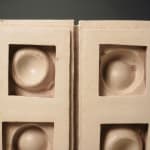Yamada Hikaru 山田光 Japanese, 1924-2001
Excavated Vases (on a Screen), 1976
Stoneware
H18.8” x W12.2” x D2.3”
H47.7 x W30.9 x D5.8cm
H47.7 x W30.9 x D5.8cm
Further images
-
(View a larger image of thumbnail 1
)

-
(View a larger image of thumbnail 2
)

-
(View a larger image of thumbnail 3
)

-
(View a larger image of thumbnail 4
)

-
(View a larger image of thumbnail 5
)

-
(View a larger image of thumbnail 6
)

-
(View a larger image of thumbnail 7
)

-
(View a larger image of thumbnail 8
)

-
(View a larger image of thumbnail 9
)

-
(View a larger image of thumbnail 10
)

Trained in Kyoto, Yamada Hikaru was known for his innovative sculptural work, moving beyond functional ceramic objects and focusing instead on abstracting traditional folk-craft forms. His work juxtaposes the organic...
Trained in Kyoto, Yamada Hikaru was known for his innovative sculptural work, moving beyond functional ceramic objects and focusing instead on abstracting traditional folk-craft forms. His work juxtaposes the organic with the inorganic, his geometric shapes contrasting the malleability of clay. This piece was inspired by findings, fossilized ceramic works from the Jomon period in Japan. He examines the idea that examination of archaeological materials looks at both the interior- the material integrity of the piece- as well as the exterior- the surface texture. The six square windows on this narrow sculpture mimic the silhouette of the interior curvature of a ceramic bowl, while the surface of this piece mimics paper textures. Alongside Suzuki Osamu 鈴木治 (b. 1926), he was one of the founding members of the influential Sodeisha movement. Formed in opposition to the folk-craft movement of Mingei, which was the dominant ceramic philosophy during the 20th century, Sodeisha sought to engage with questions regarding the relationship between ceramic aesthetics and their production, as well as the potter’s professional identity as an individual artist or a craftsperson. They used ceramic production in the context of high art to create forms distinct from inherited antique clay traditions. Yamada Hikaru’s pieces enquired on the ceramic medium as high art- sculptural rather than functional.









